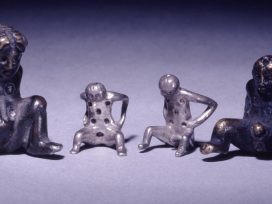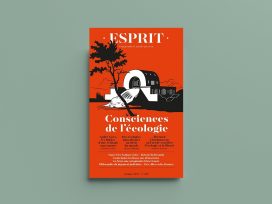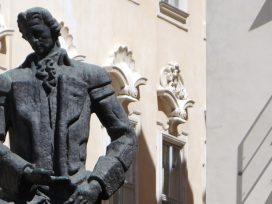Adolf Holl: Your book La Folle et le Saint [The madman and the saint], which you wrote with Catherine Clément, deals with two biographies: that of a woman interned at the Salpêtrière psychiatric clinic in Paris, and that of Ramakrishna, one of the most important mystics of the Indian modern. The ironic point of this book is that, had Ramakrishna lived in Europe, he would have ended up in an asylum, while in India the mentally disturbed woman would have been worshipped.
Sudhir Kakar: The Indian view of things is marked by special relativity. There is little of universal validity and no human can define the universal once and for all. It’s more the case that one makes do with a certain lack of knowledge, doesn’t think in categories of right or wrong, doesn’t distinguish between right and wrong actions, but rather behaves on the basis of a certain naivety. The advantage of this attitude is that one can do and risk everything, because one doesn’t know in advance if it is right or wrong. The disadvantage is that there’s a lack of stability and that identities are very fluid. The Indian world view is also very romantic and uncynical. Yes, life is seen as tragic, but there’s an order, and if one has gone about one’s life conscientiously one will arrive at the positive. Naivety and hope mark the Indian world view very strongly.
AH: Something that is perhaps connected to your remark about naivety is the absence of rigid, sharp boundaries to the ego. That is expressed in many Asian languages: “I” does not begin the sentence, but is attached to the tense and is phrased differently according to the person being spoken to. There’s the bold theory that because sharp boundaries to the ego are absent in Asia, schizophrenia can’t appear so easily, since a soft ego can’t be split.
SK: I wouldn’t go that far, but you’re right that with the Indians the boundaries to the ego aren’t as rigid. That comes from the corporeal, the body itself is open. The image of the body that one has in Ayurveda, for example, is that of a permanent exchange between the ego and the environment. If the body is open, the boundaries to the ego are also open. The body forms the basis of the ego. One views one’s body in the same way one views one’s ego, and in the Indian view this ego is more fluid. For an Indian, mental illnesses come from spirits that force their way into the body; one falls ill because of evil spirits. In the West, the ego is a fortress – that’s why in psychology many biological approaches are taken. What happens in the fortress is important and not what comes from outside. Here in the West, it would be considered esoteric to say that sunlight or stones can influence the character, because the view of the ego is different. The exchange between environment and ego is emphasized much more strongly in India.
AH: One of the most famous mystics of the Christian Occident, Teresa von Avila, spoke literally of the “castillo interior”, the “castle of the soul”. The fundamental metaphor is that souls resemble castles, enemies are outside. One must do all one can not to allow the enemy into the castle.
SK: That’s certainly an indication of how old this thinking is in the West. By the way, since you mentioned the linguistic level first: no Indian language uses the verb “have”. If I want to say “I have”, I say “It is nearby”. That also means that something can easily depart or be lost.
AH: A sentence that greatly impressed me when reading one of your texts is, “We all begin as mystics”. Here you’re hinting at the relationship between the young child and the mother and alluding to your mentor and teacher Erik H. Erikson, who in the book The young man Luther spoke of “the upturned countenance” and in doing so introduced a religious concept. In view of Western religious studies’ difficulties in defining the nature of religion – a leftover category knocked to a pulp under the hammer blows of the Enlightenment – the reference to the child’s early behaviour seems very obliging, because it allows me to escape the rigidly self-demarcating concept of God in Christian monotheism and sense a certain relief.
SK: For me, the most important religious moment, one that Erikson also hints at, is the gaze into the mother’s countenance, in which the child also sees itself. That is religious awe, entrancement, magic. Human beings want to rediscover this magic in religion. Everything else is belief in theory and not so important as religion. This awe, this magic, is actually sought in all possible kinds of religion and, as long as the religion is not some dead ritual, can also be found.
AH: In your writings on the comparison between India and the West, you stress that with you the maternal relationship has a great deal more social impact than with us.
SK: I think that the maternal relationship has an impact everywhere. However, in public discourse, the place where everything is negotiated, in images of God or in the media, it has less impact in the West. In India, maternal gods are far more significant than paternal gods; the latter are distant figures. One invokes goddesses – like Indian fathers, gods are more removed. That’s a major difference to the West – here father gods are more present.
AH: The god Shiva appears in the company of the “high-breasted” Parvati, whose parents are very unhappy, because Shiva is frivolous, and the parents fear that he will lead Parvati astray. In the Shiva myths there is a constant exchange between the male and the female principle, overall, however, the story finishes badly. At the end, Shiva dances with the dead Parvati through the cosmos, in order to destroy the universe.
SK: Shiva is the destroyer. However, his destructive fury must first be woken, because normally he is sunk in meditation. He became angry only after Parvati’s death. There are many myths telling how Shiva’s fury can be woken. In the myths, the male gods represent material; energy comes from the female gods. Together they stand for life as a whole.
AH: I mention Shiva, because for a long time I’ve been toying with the thought of making a literary attempt to represent Adolf Hitler in the language of Indian mythology. In the West, particularly in Austria and Germany, we’re not placed to deal with Hitler in a form in which we can integrate him. Perhaps the ancient, long gone ways of dealing with evil, for example the Shiva stories, are an appropriate medium for suggesting how to integrate these destroyers.
SK: I think that one should integrate the destructive so that it doesn’t remain foreign to one, one should discover it in oneself and so be able to arm oneself against it, because in doing so one can also incorporate such figures. However, I wouldn’t attribute the destructive to Shiva so much as to other demon kings, Ravana for example. There are several such figures in Indian mythology who, having first prayed to Shiva for a long time, as soon as they received his blessing considered themselves invincible and went over to evil. Vishnu, who embodies the principle of life, had to find the ways and means to bring these demon kings to reason. If anything I’d place Hitler among these demon kings.
AH: Is this sophisticated form of mythographic engagement with good and evil still retold in India today?
SK: The Indian imagination today is still deeply influenced by these myths. They are retold and choreographed, they determine the dramaturgy of Bollywood films and form the world view of the masses.
AH: Our stunned reaction to the history of National Socialism can be seen in relation to the disappearance of our popular mythology and the protection provided by fairytales.
SK: With us it’s the reverse: the fairytale is the reality. It is thought that myth expresses the truth.
AH: What would Freud have said about that? You are yourself also a trained and practising psychoanalyst.
SK: I came to Freud because I wanted to get away from the world of fairytales. When I began to read Freud at the age of twenty, of course I thought that I could recognize what lay behind all the myths and fairytales and how they ought to be interpreted. Now that I’m older, often I’m not so convinced that I went about the business in the right way.
AH: How do you define yourself? Are you more a Western or an Indian intellectual?
SK: As far as this is concerned, I am in a no-man’s-land. In India, I argue in a more Western way, because I want to cause a bit of a stir there; in the West, it’s the other way round, there I’m more Indian. In that respect I practice a fluid identity.
AH: Could you imagine writing a book about the Europeans similar to yours about the Indians, a portrait of our society from a distanced point of view?
SK: I think for that you also need your own childhood experience, which I don’t have as far as the West is concerned. To write something like that solely from the adult perspective would be omitting something fundamental, it wouldn’t be vital enough. I haven’t had the Western child’s experience of being spellbound. Having said that, there are one or two aspects that interest me a great deal, the difference in expletives for example. While in the West expletives are primarily scatological, with us they are incestuous.
AH: In your last book I particularly liked the story about the Indian singer who comes to London and has problems with the hygiene, which doesn’t meet up to the standards of cleanliness she’s used to. It’s told from the perspective of a foreign, outraged view of our civilization. Nowadays, India is as near to us as the next Ayurveda clinic. But perhaps one’s deluding oneself there, too, if one thinks one understands something about India as soon as one undergoes some Ayurveda wellness treatment.
SK: I welcome all these things that have come to the West through globalization. The fact that most people can’t penetrate the essence because they consume it like anything else need not matter. However, there are always individuals for whom the door is opened, and who want to go deeper. Some were deeply influenced by Hermann Hesse’s Siddartha. I’m not one of those who say that everything always has to be authentic.
AH: So you’re not an advocate of bloc thinking like Samuel Huntington, for example. You also cite Clifford Geertz, who talks instead of a world view made up of many small cultures with an official structure in which Muslim societies are also visible. So you’re advocating an exchange between cultures, like at the beginning of our conversation you described the porosity between the Indian bodily ego and its environment. One might wish for a contemporary situation, namely two-way influence that doesn’t immediately give way to animosity.
SK: Confrontations are always caused by castles. As soon as one doesn’t retreat into one’s castle and instead allows a fluid process, then self-reflection and exchange, renewal, new ideas and revitalization are possible. Otherwise, it inevitably comes to a confrontation of cultures.
AH: This brings us to the confrontation between Moslems and Hindus. You describe very clearly how murderous attacks such as that in Bombay arise, namely through rumour and paranoia. You refer in this regard to “the paranoia of us all”, thereby making a strong statement about our human disposition. In the case of Muslims and Hindus, there are certain structural conditions that allow this paranoia to revive again and again.
SK: We’re all born paranoid; becoming depressed is a great effort. But the original paranoia keeps on appearing. The fury of radical Muslims and Hindus doesn’t have religious roots. I have conducted surveys on the integration of Muslims and Hindus. The aim was to find out how certain situations such as communal eating, working together, renting rooms from members of the other religious group, but also existential experiences such as death and acts of violence, are experienced and judged differently by Muslims and Hindus. For me, the most astonishing result was that both groups have absolutely no problem with converts. Converting from Hinduism to Islam or the other way around was not judged negatively by any of the persons tested. Our evaluation showed that the worst problem, especially for Muslims, is when a Hindu boy goes to the cinema with a Muslim girl. So it isn’t religion but anthropology that is decisive. With Hindus, much more disgust is caused by the fact that Muslims eat beef than by theological differences. Disgust arises because one can’t eat together with the other group. Religious differences are relatively unimportant.
AH: One can read your book, The Indians, as a sociology of the middle class, as a description of a section of society that is the bearer of globalization.
SK: The Indian middle class comprises between three hundred and five hundred million people and growing. In cities and in education it is very Western-influenced. But it is also traditional – it doesn’t want to be absolutely Western. Fundamentalism is also very pronounced in this class; the leaders of the radical Hindu parties can all be aligned to this class. Indian middle class Hindus are generally flexible personalities who take on a lot from the West, but it is also important to them not to lose their Hindu identity. One sees this in marriage customs, when IT professors, for example, having been in the US for years, often return home for an arranged marriage with an Indian woman. And yes, of course they are the bearers of globalization, especially as far as their consumption behaviour and their life hopes are concerned. Western influences can be discerned particularly in these latter areas. Globalization is actually not rejected by Hindu nationalists, and that’s the biggest difference with Christian and Muslim fundamentalists. The only thing that is strictly rejected by all is liberated Western sexuality. All fundamentalists are scared of the sexual aspect of the modern. The Hindus define themselves as the winners of globalization in the areas of technology, finance, and communication, while the Muslims consider themselves more as losers.
AH: In China, three hundred cities are currently being built, each for a million people, in order to reduce the rural population from seventy to forty per cent. In the last five thousand years of our history, however, religion has taken place in the countryside. When people migrate to the cities they lose their religion.
SK: In India, city planning like that couldn’t happen due to the system of Indian democracy. Of course, migration from the countryside also occurs with us, however, completely uncontrolled and to cities that already exist and which therefore are bigger. However, religion in cities is not on the decline in India, on the contrary, it has increased in the last thirty years.
AH: On my last visit to Delhi, a filmmaker, a woman of high caste brought up in the West, told me about a recurring dream. In it, she is a man and is riding across a plain, crying uncontrollably because the relationship to her loved one has fallen apart. The astrologer she visits has interpreted the dream as the unresolved karmic leftover from a previous existence and pointed out how she might work on it in her current marriage and integrate it into her current life.
SK: Astrologers are psychotherapists for the majority of the Indian society. They do the same thing, draw up a scenario, explain the connections, offer suggestions for solutions. Diagnoses and prognoses are made, like psychotherapy, just a lot cheaper.
AH: Western intellectuals would describe that as regression to pre-Enlightenment thought.
SK: One could cite that great Enlightenment thinker, Freud, who said that any psychotherapy that helps is good.
AH: So in India old, pre-modern ways of dealing with mental problems are still alive. They continue to have an effect and it can’t be expected that they will cease to function under the force of globalization.
SK: As long as belief exists in the mystical behind the real, which in contrast to Freud’s hard reality makes for the softness of the Indians, and as long as the Indian world view also includes the occult, then Gurus, ascetics, and astrologers will continue to play an essential role.
AH: Fears of globalization are often guided by paranoia. One fears that the Other, the foreign, is dangerous, because it might be superior. Do you think that Indian society, because of some of the aspects that have featured in this conversation, is superior to the West?
SK: Materially, people are incomparably worse off in India than in the West. Indian society is superior in one aspect alone: it is more hopeful. That has to do with the fact that seventy per cent of the population are under twenty-five, and youth tends to be hopeful. However, there are cultural as well as demographic reasons for the Indian principle of hope. The Hindu belief in reincarnation plays a part; time is also experienced as more unlimited.
AH: At Tirupati, a Hindu pilgrimage site four hours from Madras by car, 350 000 euros are taken daily, and in the cellars there are ten tons of pure gold in the form of sacred offerings. Even the Vatican comes nowhere near. There must be a very strong religiosity in India for these old myths to persevere. With us, this power is gone, I’d say.
SK: But the search for spiritual and mystical comfort also exists in the West. It’s just that the religious institutions don’t meet this need. In India, these needs are also encouraged in adulthood, as are daydreams and fantasies. There, reality is no more important than fantasy. In the West, on the other hand, the mystical beginnings of our development are warded off.
AH: The leading icon is a dead man on a cross.
SK: But Christ as a child plays a major role in Occidental iconography – and you, Mr Holl, have even written a book about the laughing Christ.
AH: But that would lead us from the Indian view of things, and perhaps at this juncture we should simply end our conversation with a smile.
Moderated and edited by Walter Famler






